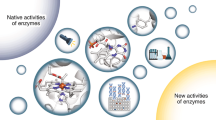Abstract.
Directed evolution has emerged as a key technology to generate enzymes with new or improved properties that are of major importance to the biotechnology industry. A directed evolution approach starts with the identification of a target enzyme to be optimized and the cloning of the corresponding gene. An efficient expression system is needed before the target gene is subjected to random mutagenesis and/or in vitro recombination, thereby creating molecular diversity. Subsequently, improved enzyme variants are identified, preferably after being secreted into culture medium, by screening or selection for the desired property. The genes encoding the improved enzymes are then used to parent the next round of directed evolution. Enantioselectivity is a biocatalyst property of major biotechnological importance that is, however, difficult to deal with. We discuss recent examples of creating enantioselective biocatalysts by directed evolution.
Similar content being viewed by others
Author information
Authors and Affiliations
Additional information
Received revision: 9 February 2001
Electronic Publication
Rights and permissions
About this article
Cite this article
Jaeger, .KE., Eggert, .T., Eipper, .A. et al. Directed evolution and the creation of enantioselective biocatalysts. Appl Microbiol Biotechnol 55, 519–530 (2001). https://doi.org/10.1007/s002530100643
Received:
Accepted:
Issue Date:
DOI: https://doi.org/10.1007/s002530100643




